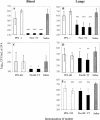Immunization of female mice with glycoconjugates protects their offspring against encapsulated bacteria
- PMID: 14688096
- PMCID: PMC343960
- DOI: 10.1128/IAI.72.1.187-195.2004
Immunization of female mice with glycoconjugates protects their offspring against encapsulated bacteria
Abstract
The immune system of the newborn is immature, and therefore it is difficult to induce protective immunity by vaccination in the neonatal period. Immunization of mothers during pregnancy against infections caused by encapsulated bacteria could thus be particularly attractive, as infants do not respond to polysaccharide (PS) antigens. Transmission of maternal vaccine-specific antibodies and protection of offspring against pneumococcal bacteremia and/or lung infection were studied in a neonatal murine model of pneumococcal immunization and infections. Adult female mice were immunized with native pneumococcal PS (PPS) of serotypes 1, 6B, and 19F or PPS conjugated to tetanus protein (Pnc-TT), and PPS-specific antibodies were measured in sera of mothers and their offspring. Effective transmission of maternal antibodies was observed, as PPS-specific immunoglobulin G levels in 3-week-old offspring of immunized mothers were 37 to 322% of maternal titers, and a significant correlation between maternal and offspring antibody levels was observed. The PPS-specific antibodies persisted for several weeks but slowly decreased over time. Offspring of Pnc-TT-immunized mothers were protected against pneumococcal infections with homologous serotypes, whereas PPS immunization of mothers did not protect their offspring, in agreement with the low titer of maternal PPS specific antibodies. When adult female mice were immunized with a meningococcal serogroup C conjugate vaccine (MenC-CRM), antibody response and transmission were similar to those observed for pneumococcal antibodies. Importantly, bactericidal activity was demonstrated in offspring of MenC-CRM-immunized mothers. These results demonstrate that this murine model of pneumococcal immunization and infections is suitable to study maternal immunization strategies for protection of offspring against encapsulated bacteria.
Figures




Similar articles
-
Protective levels of polysaccharide-specific maternal antibodies may enhance the immune response elicited by pneumococcal conjugates in neonatal and infant mice.Infect Immun. 2005 Feb;73(2):956-64. doi: 10.1128/IAI.73.2.956-964.2005. Infect Immun. 2005. PMID: 15664938 Free PMC article.
-
Pneumococcal capsular polysaccharide vaccine-mediated protection against serotype 3 Streptococcus pneumoniae in immunodeficient mice.Infect Immun. 2007 Apr;75(4):1643-50. doi: 10.1128/IAI.01371-06. Epub 2007 Jan 12. Infect Immun. 2007. PMID: 17220309 Free PMC article.
-
Antibody responses after primary immunization in infants born to women receiving a pertussis-containing vaccine during pregnancy: single arm observational study with a historical comparator.Clin Infect Dis. 2015 Dec 1;61(11):1637-44. doi: 10.1093/cid/civ695. Epub 2015 Sep 15. Clin Infect Dis. 2015. PMID: 26374816
-
Immunogenicity differences of a 15-valent pneumococcal polysaccharide conjugate vaccine (PCV15) based on vaccine dose, route of immunization and mouse strain.Vaccine. 2017 Feb 7;35(6):865-872. doi: 10.1016/j.vaccine.2016.12.055. Epub 2017 Jan 10. Vaccine. 2017. PMID: 28087148 Review.
-
Protective immunity of pneumococcal glycoconjugates.Crit Rev Microbiol. 2003;29(4):333-49. doi: 10.1080/713608018. Crit Rev Microbiol. 2003. PMID: 14636043 Review.
Cited by
-
Animal models of Streptococcus pneumoniae disease.Clin Microbiol Rev. 2008 Oct;21(4):666-85. doi: 10.1128/CMR.00012-08. Clin Microbiol Rev. 2008. PMID: 18854486 Free PMC article. Review.
-
Is Antibody-Dependent Enhancement of Trypanosoma cruzi Infection Contributing to Congenital/Neonatal Chagas Disease?Front Immunol. 2021 Sep 10;12:723516. doi: 10.3389/fimmu.2021.723516. eCollection 2021. Front Immunol. 2021. PMID: 34566981 Free PMC article.
-
Dose-sparing effects of novel adjuvants and aluminum hydroxide on two different vaccines in a neonatal mouse model.Front Immunol. 2025 Jul 31;16:1646677. doi: 10.3389/fimmu.2025.1646677. eCollection 2025. Front Immunol. 2025. PMID: 40821849 Free PMC article.
-
Protective levels of polysaccharide-specific maternal antibodies may enhance the immune response elicited by pneumococcal conjugates in neonatal and infant mice.Infect Immun. 2005 Feb;73(2):956-64. doi: 10.1128/IAI.73.2.956-964.2005. Infect Immun. 2005. PMID: 15664938 Free PMC article.
-
Streptococcus pneumoniae Transmission Is Blocked by Type-Specific Immunity in an Infant Mouse Model.mBio. 2017 Mar 14;8(2):e00188-17. doi: 10.1128/mBio.00188-17. mBio. 2017. PMID: 28292980 Free PMC article.
References
-
- Åhman, H. 1999. Immune response to pneumococcal conjugate vaccine in infants: effect of maternal antibodies on responses to pneumococcal conjugate vaccines in infants. University of Helsinki, Helsinki, Finland.
-
- Ahouse, J. J., C. L. Hagerman, P. Mittal, D. J. Gilbert, N. G. Copeland, N. A. Jenkins, and N. E. Simister. 1993. Mouse MHC class I-like Fc receptor encoded outside the MHC. J. Immunol. 151:6067-6088. - PubMed
-
- Austrian, R., and J. Gold. 1964. Pneumococcal bacteremia with specific reference to bacteremic pneumococcal pneumonia. Ann. Intern. Med. 60:759-776. - PubMed
-
- Balmer, P., and E. Miller. 2002. Meningococcal disease: how to prevent and how to manage. Curr. Opin. Infect. Dis. 15:275-281. - PubMed
Publication types
MeSH terms
Substances
LinkOut - more resources
Full Text Sources

